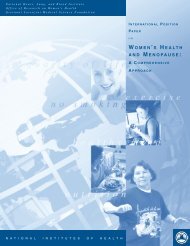HeartsNParks Community Mobilization Guide - National Heart, Lung ...
HeartsNParks Community Mobilization Guide - National Heart, Lung ...
HeartsNParks Community Mobilization Guide - National Heart, Lung ...
You also want an ePaper? Increase the reach of your titles
YUMPU automatically turns print PDFs into web optimized ePapers that Google loves.
Get moving<br />
for a healthy heart<br />
<strong>Heart</strong> disease is the leading cause of death<br />
in the United States. Fortunately, though,<br />
you can take steps to reduce your risk of<br />
heart disease. For example, getting regular<br />
physical activity can help protect you and<br />
your family against high blood pressure and<br />
overweight and obesity—factors that, along with<br />
high blood cholesterol and smoking, increase<br />
the risk of heart disease.<br />
Staying active also helps keep off extra pounds,<br />
control blood pressure, boost the level of “good”<br />
HDL-cholesterol, and prevent diabetes and heart<br />
attacks. It also strengthens the lungs, tones the<br />
muscles, keeps the joints in good condition,<br />
improves balance, helps prevent and treat<br />
depression, and helps many people cope better<br />
with stress and anxiety.<br />
If you already have heart disease, regular, moderate<br />
physical activity lowers your risk of death from<br />
heart-related causes. (However, if you have heart<br />
disease, check with your doctor first to find out<br />
what kinds of activities are best for you.)<br />
The earlier you start, the better. The best time to<br />
start learning heart-healthy habits is in childhood,<br />
because heart disease risk factors start developing<br />
then too. Still, it’s never too late to begin living<br />
heart-healthy. This is true even for people in their<br />
‘80s and ‘90s.<br />
Here’s some advice about physical activity from<br />
the <strong>National</strong> <strong>Heart</strong>, <strong>Lung</strong>, and Blood Institute<br />
(NHLBI) and the <strong>National</strong> Recreation and Park<br />
Association (NRPA):<br />
• To reap benefits from physical activity, you<br />
don’t need to train for a marathon. You need<br />
to engage in only about 30 minutes<br />
of moderate-level activity on most—<br />
and preferably all—days of the week.<br />
A moderate-level activity is one that’s<br />
about as demanding as brisk walking.<br />
• Other examples of moderate physical activity<br />
that can improve heart health are bicycling,<br />
conditioning or general calisthenics, racquet<br />
sports (such as table tennis), jogging, swimming,<br />
dancing, housework, gardening, or lawn<br />
mowing.<br />
• You can engage in any of these activities for 30<br />
minutes at one time, or you can do them in<br />
shorter periods of at least 10 minutes each, as<br />
long as you total approximately 30 minutes<br />
each day.<br />
• If you are already engaging in this level of<br />
physical activity, you will receive extra health<br />
and fitness benefits by doing these activities for<br />
a longer period each day or becoming involved<br />
in more vigorous activity.<br />
Special Tips for Kids, Adults, and Seniors:<br />
Young people should be physically active—<br />
both in and out of school. Instead of television,<br />
video games and the computer, kids need to be<br />
engaged in “active play,” such as tag, jump rope,<br />
hide and seek, or bicycling, or team activities like<br />
soccer, basketball, and softball.<br />
Another way to increase children’s activity levels<br />
is to get them involved in everyday activities, like<br />
household chores, walking the dog, or helping<br />
with the groceries.<br />
F-7
















